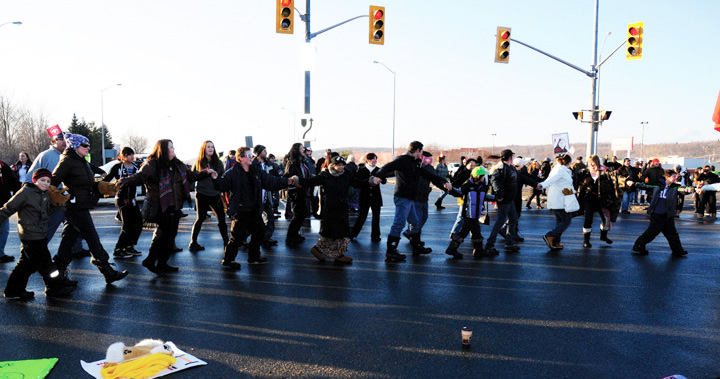IPPERWASH SERIES 2/3: Post-Ipperwash policing in Ontario

The Labour Day long-weekend marked 19 years since the reclamation of Ipperwash Provincial Park, part of Aazhoodena (Stoney Point) ancestral lands. What began as a peaceful demonstration – not unlike numerous other struggles for Indigenous lands across Canada – ended in the shooting death of unarmed Dudley George by an Ontario Provincial Police sniper. This was the first killing of an Indigenous person in a land-rights dispute in Canada since the 19th century.
Respecting the spirit of resistance and resolve embodied by Dudley, this series of articles takes a critical look at post-Ipperwash Ontario.
By Nicole Latulippe
Post Ipperwash, the Ontario Provincial Police (OPP) has been criticized for its failure to end Idle No More blockades and other protest disruptions. In defense, OPP Commissioner Lewis has said that he would rather be criticized for a decision not to jeopardize people’s lives than for taking unnecessary, aggressive action.
Such police handling of Aboriginal demonstrations aligns with an overall strategy adopted by the OPP in the aftermath of the fatal 1995 shooting of Dudley George. Out of 100 recommendations made in the 2007 Report of the Ipperwash Inquiry, over forty detail a “peacekeeping” approach to the policing of Aboriginal protests and occupations in Ontario.
Echoing the report, Lewis says that police services are in no position to resolve longtime disputes that are most often at the heart of Aboriginal blockades and reclamations. Disputes, like the treaty grievances and unresolved land claim at Ipperwash and Idle No More’s resistance to ongoing government assimilation and termination plans, are inherently political.
The 2007 Report of the Ipperwash Inquiry cautioned against the convergence of political and public policing.
Yet, in Behind the Blue Line, Tia Dafnos reveals that structural, operational, and policy reforms to provincial policing since Ipperwash emphasize negotiated management alongside features of militarization.
On the one hand, the 2006 Framework for Police Preparedness for Aboriginal Critical Incidents emphasizes flexibility, respect, negotiated management, and minimal use of force. The OPP actively engages Aboriginal liaisons to build trust with communities.
But, the framework is operationalized through processes of militarization – the involvement of military forces and paramilitarized law enforcement.
Any event asserting Aboriginal or treaty rights, defined as an Aboriginal critical incident, is implicitly deemed “high risk”. This designation mobilizes paramilitarized units, which provide heavily armed support including police snipers.
And intelligence-led policing facilitates the new OPP framework. Threat assessments warned of potential unrest long before Idle No More.
In recent years, high profile events have provided opportunity for the OPP to apply its new approach. Police response to blockades during the 2006 reclamation at Caledonia and the 2007 National Day of Action at Tyendinaga has been touted as proof of the OPP’s new ‘measured approach’.
Yet, documents revealed through Access to Information (ATI) show that these events were framed as threats to national security, explains Dafnos. A securitized police response included the militarization of operations as well as covert surveillance, the cultivation of informants, and intelligence-led policing.
Troubling is the role played at Caledonia and Tyendinaga by Indian and Northern Affairs Canada, the federal agency responsible for managing the state’s relationship with Aboriginal peoples. Drawing on its power as land claims arbitrator, INAC used preemptive measures of ‘negotiation’ and contributed to multi-agency intelligence gathering. Their involvement was geared towards law enforcement and security, not a genuine commitment to the resolution of land claims.
Events at Caledonia and Tyendinaga exemplify the securitization of policing since Ipperwash. Familiar to Canadians since 2001, this trend in policing delegitimizes the underlying issues and blurs Aboriginal activism with criminality and terrorism.
Epitomizing this shift is a massive state-wide surveillance and hot spot monitoring operation coordinated between the Department of Indian Affairs, the Royal Canadian Mounted Police (RCMP), the Canadian Security Intelligence Service (CSIS), local security forces, natural resource and transportation ministries, border agencies, and industry stakeholders. It defies calls from the Ipperwash Inquiry to avoid or reduce political interference in policing.
According to writer and researcher Shiri Pasternak, this surveillance is justified as a means of protecting Canada’s critical infrastructure. Given their proximity, transportation corridors, energy sectors, and sites of natural resource extraction are feared to be at the mercy of rural First Nations communities.
Fear, manifest in the securitization of policing, maintains the economic status quo.
Lewis is right in stating that police forces are ill equipped to resolve longstanding disputes. But, we need to be clear about the stakes. Pasternak suggests that the relatively hands-off approach taken by police until now represents a concerted effort to contain the enormous economic power wielded by coordinated First Nations.
With First Nations framed as the major threat to Canada’s resource extraction economy, the National Post reported recently that the Canadian forces spent virtually all of 2013 watching Idle No More protesters.
The issue is one of land and access to resources and energy flows.
Police have historically played a central role in the dispossession and exclusion of Aboriginal peoples, embodied more recently by the fatal shooting of Dudley George. Dafnos asks that we consider how historically based forms of domination continue to shape current practices.
Against the spirit of the Ipperwash Inquiry and the Idle No More movement, government documents reveal far more coercive and intrusive intelligence gathering and a justification for decreased transparency in policing. This both masks and reinforces unequal relations of power between police and Indigenous peoples, critical to the exercise of colonial power and ongoing extraction of wealth from First Nations territories.
To learn more about the events surrounding Ipperwash Park, visit http://www.anishinabek.ca/ipperwash.asp
Nicole Latulippe is a PhD Candidate in the Department of Geography at the University of Toronto. In partnership with Nipissing First Nation, her dissertation research is on the Lake Nipissing fishery, Indigenous knowledge and governance systems, and the treaty relationship. Formerly, she worked with the Union of Ontario Indians on the Ipperwash implementation process.


